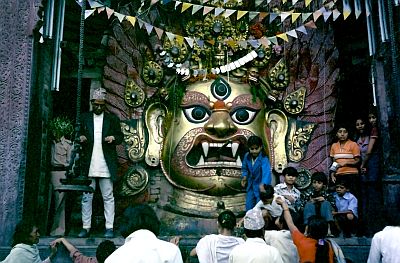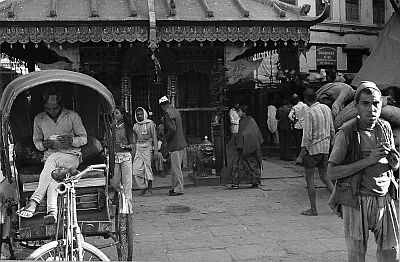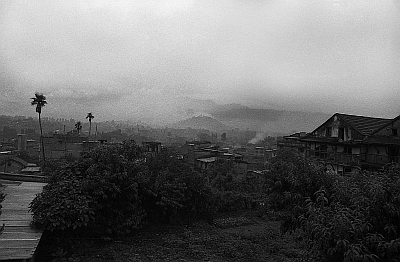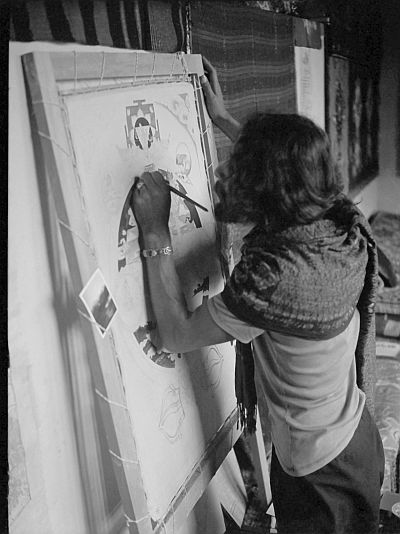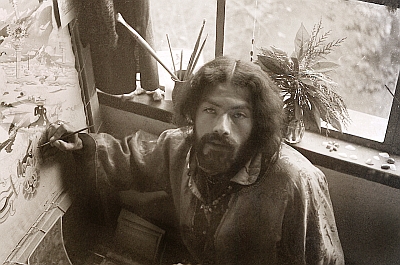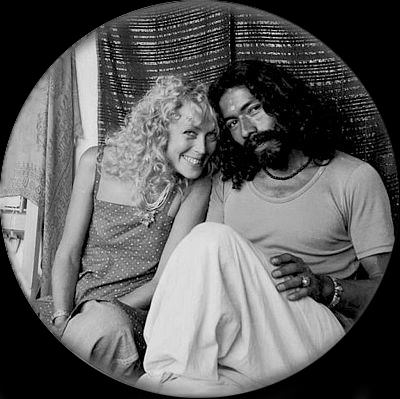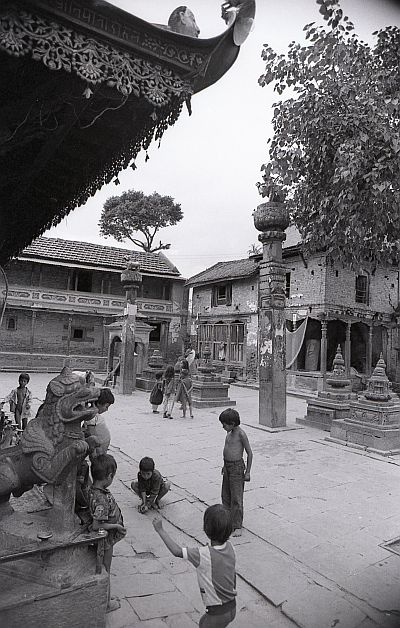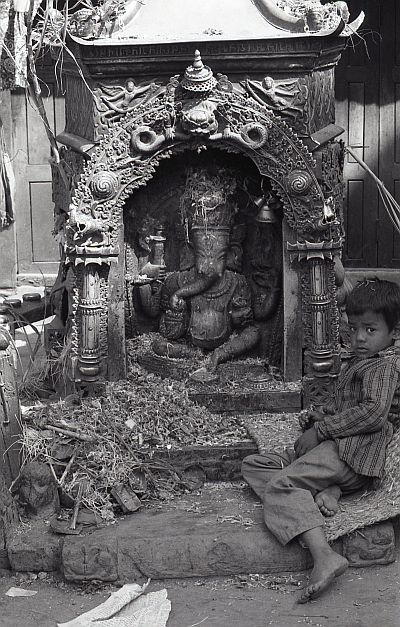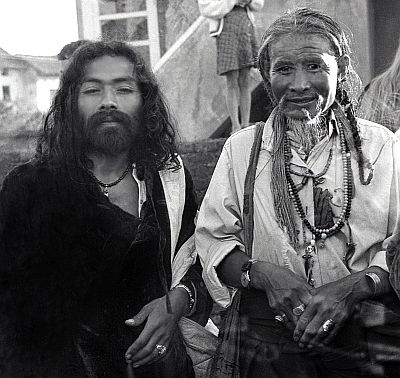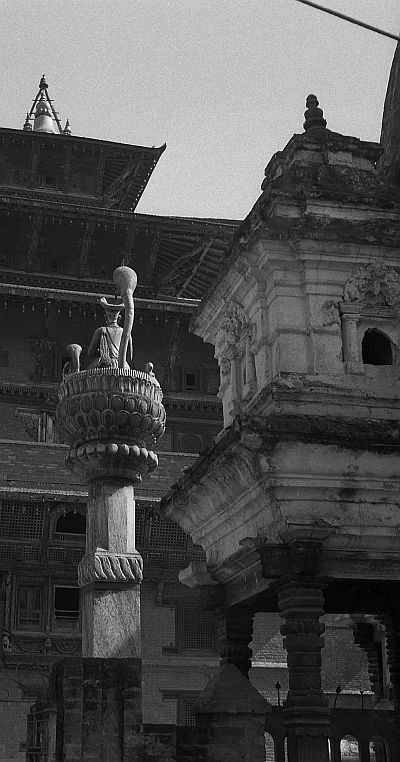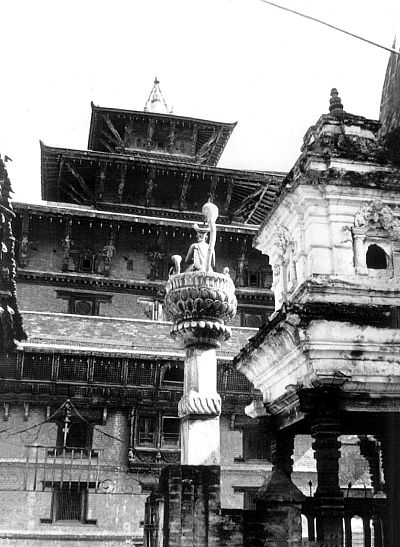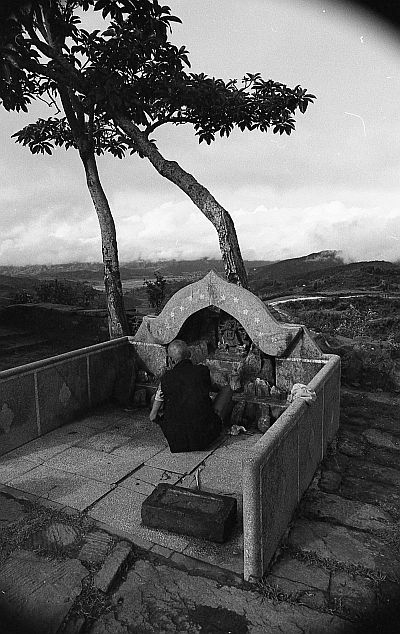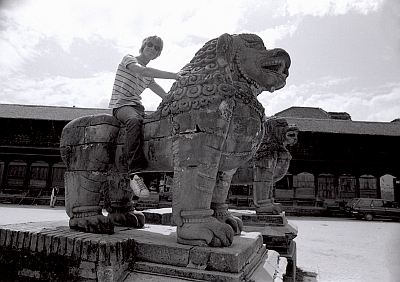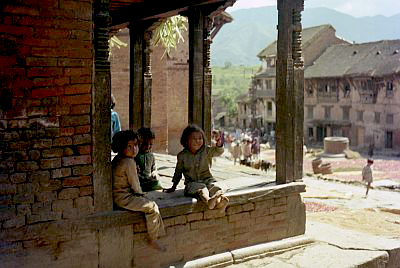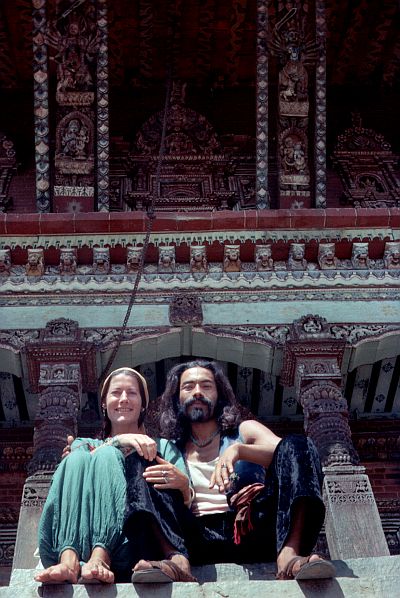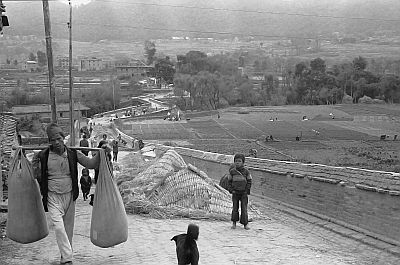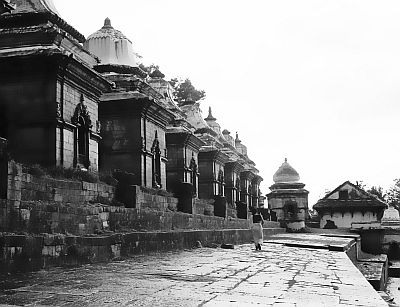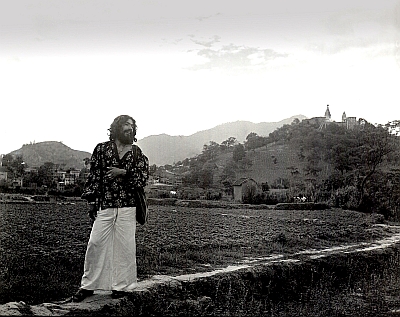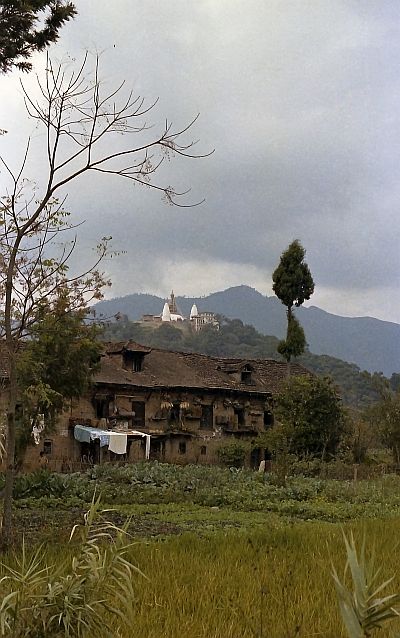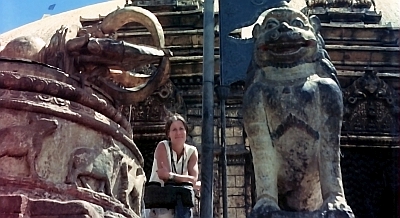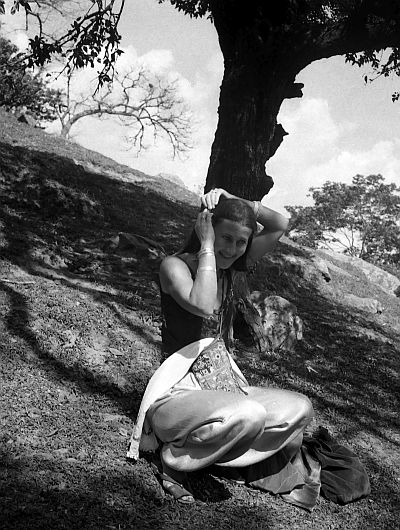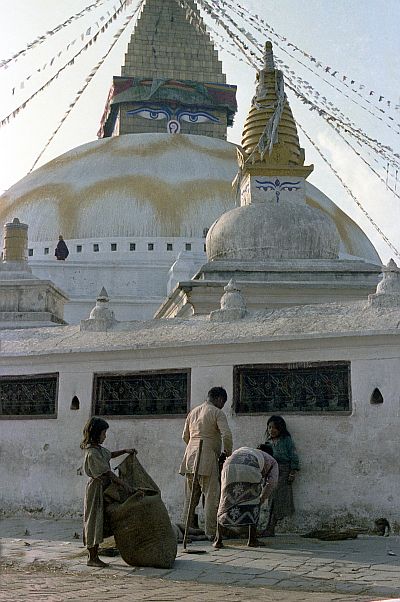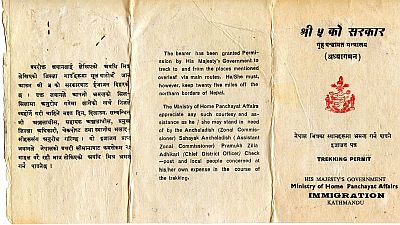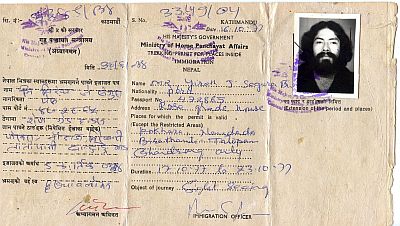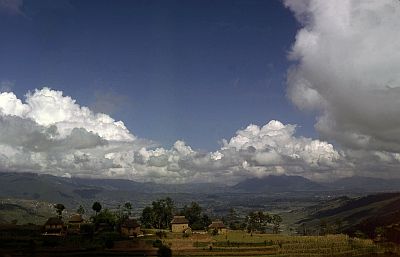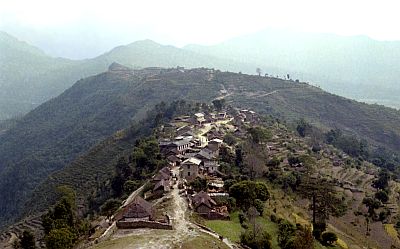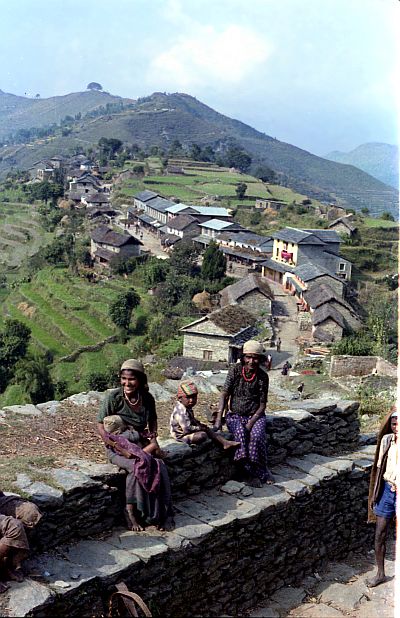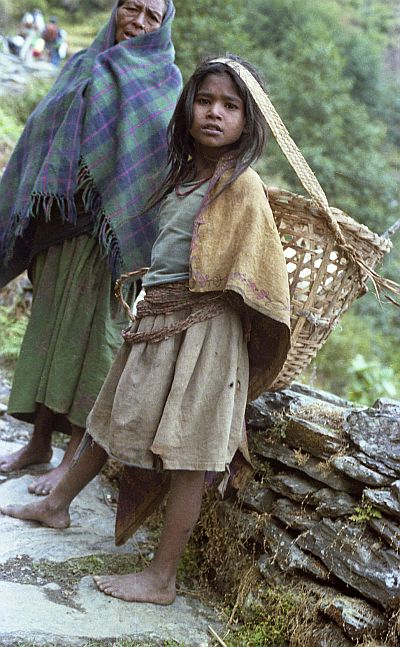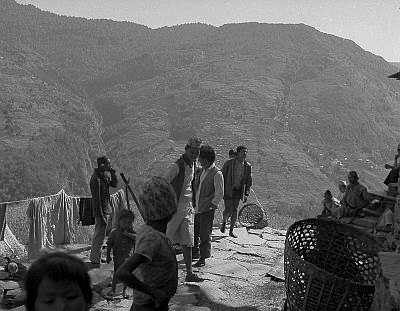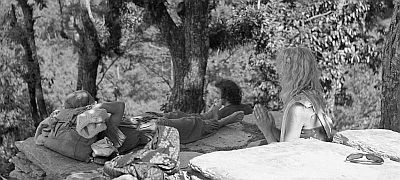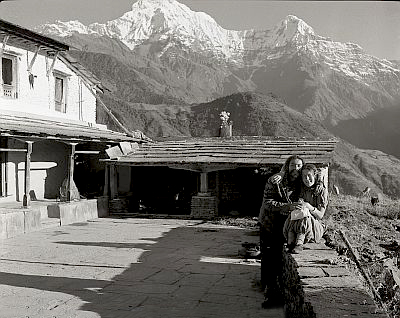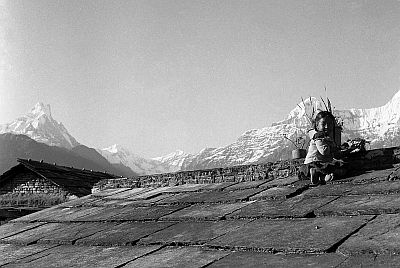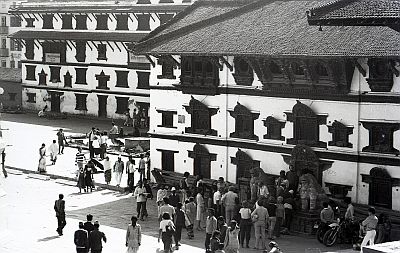Shambhala
The Kingdom of Nepal
The way of the White Clouds
Scroll Down Click & Play
Click & Play
Preparing a giant chariot for the Bunga Dyah Jatra or Rato Machhendranath Jatra Fest
in Kathmandu, honoring the Buddhist deity of compassion Avalokiteśvara
Gisela Schütze and Vicente Segura
In the Land of Siddhārtha
THE HIPPIE TRAIL
1976 / 1978
PART 2
NEPAL
All photos and drawings by Vicente Segura & Gisela Schütze © copyright 1975 - 2020.
All right reserved
Please, click the image to Zoom
In the Hands of Buddha
Gisela & Vicente in the hands of a Tibetan Buddha at
the foot of the Swayambhunath Temple or Monky Temple.
At this point of our journey we was very far away from the Western civilization totally immersed in a mystical nation and embracing Buddhism with love and compassion.
We were totally free of capitalism, consumerism, trash food, fake news, television, Hollywood, jeans, rock´n´roll, etc., something that we were not missing at all.
We become real people contacting real, glorious humans of other cultures in its splendor. Goodbye fashion, hello native people of the world.
We had restore our sovereignty and we had recover our freedom, free from the whole cultural entropy that involves the dystopian Western World.
In Kathmandu we prove the idea of the antipodes Cuzco-Kathmandu (Andes/Himalayas),
two magnetic fields in the Planet.
We was in the other side of the world.
We were not backpackers tourists,
but hippie travelers.
(The photos published in this page are the synthesis of our two times in Nepal in the same journey 1976 - 1978: after India and after Bali)
Kathmandu
The Kathmandu Valley
(Kathmandu from outside the city)
Kathmandu 1977
In Kathmandu Tibetans and Nepalis are coexisting peacefully together and in harmony.
Kathmandu has a multi ethnic population within a Hindu and Buddhist majority and displays a full range of historic and artistic achievements. Kathmandu is part of the UNESCO World Cultural Heritage.
The Newars are the historical inhabitants of the Kathmandu Valley, and are the creators of its historic heritage and civilization. Newars, form a linguistic and cultural community of primarily Indo-Aryan and Tibeto-Burman ethnicity following Hinduism and Buddhism with Nepal Bhasa as their common language.
Kathmandu Valley it´s at an elevation of approximately 1,400 meters. The city was the royal capital of the Kingdom of Nepal, but, since 2008 its a democratic republic with a population of around 1 million.
According to the Nepali calendar we were living the year of 1097 in 1977. The Calendar era began on 20 October 879 AD.
The Kings Road in Durbar Square, Basantapur
The Kings Road in Durbar Square, Basantapur
The Kings Road in Durbar Square, Basantapur
The God Bhairab
( The Worship of a fearful God )
The traditional Akash Bhairav Puja (Worshiping) is accompanied by
Upasana and Anusthan. Sacred water, sandalwood, flowers, fruits, incense,
and naibedya are some of the offerings for this ceremony.
Legend has it that worship of the Bhairav is usually a mark of safety and strength.
In the Nepali imagination, the Akash Bhairav symbolizes protection and
goodwill for the nation and its people.
Read more
The God Mahakala
Mahakala (Sanskrit: महाकाल; IAST: Mahākāla) is a deity
common to Hinduism, Buddhism and Sikhism. According to Hinduism,
Mahakala is a manifestation of Shiva and is the consort of Hindu Goddess
Kali and most prominently appears in Kalikula sect of Shaktism
Both Mahakala and Kali/Mahakali represent the ultimate destructive power of Brahman and they are not bounded by any rules or regulations.
They have the power to dissolve even time and space into themselves and exist as Void at the dissolution of the universe. Buddhist worship Mahakala to calm him down and prolong life.
Read more
Kids hanging around the terrible God Mahakala
The Asan Tol Market
Asan Tol is a ceremonial, market and residential square in central Kathmandu. It is one of the most well-known historical locations in the city and is famed for its bazaar, festival calendar and strategic location. Asan has been described as one of the fine Newar examples of a traditional Asian bazaar.
Nepali people in Durbar square
Beautiful Nepalese people in Makhan Tol, looking at me
Wonderful human beings in Makhan Tol, attracted by my person
Garuda emerging from the earth in Makhan Tole
Kings Road in Hanuman Dhoka - Chandri Chock
Kings Road in Hanuman Dhoka - Chandri Chock
Enjoying the day, sourrounded by beautiful wood carving
Beautiful people around the World Cultural Heritage City of Katmandu
Nice pensioners in great mood, relaxing and socializing
Tibetans and Nepalis cohexisting peacefully together.
One of the busy streets of Kathmandu
Our New Home
The name of our new house was called "The Rose Garden" near to Durbar Square in Kathmandu
With a view to Swayambhunath Stupa in the hills
( Here is where Gisela got inspired to become mother of the universe).
Our friend Ricardo is looking out of the window.
Our Hindu neighbours in the house.
A view from our sleeping room
A view from our sleeping room
Gisela in the studio of our "Rose Garden" House
Gisela playing a Nepali flute
Gisela had read and wrote a lot about Buddhism
and was deeply involve.
Gisela displaying her beauty.
But, she was, also, very happy with her beautiful belly:
she become pregnant in Kathmandu after we was back
from Bali.
So, we star to look for a name for our future child that
at this point we didn´t know if would be a boy or a girl,
so, we look for both names with a Hindu-Quechua fusion.
Our future child suppose to be born in Frankfurt Germany.
Gisela reading a Buddhist book
Vicente learning the traditional Buddhist Thanka Painting
Vicente into a work in progress painting a Mandala
Work in progress finishing a Mandala
The unfinished work.
This is the final result of my Mandala painting
A Buddhist Thanka titled "Maya".
A Sacred Art
Lisbeth is visiting Gisela for a chat
...and, also, for a photo
Monique, a french friend with her daughter is visiting us
A friend of us, Ira Cohen (a Living Theatre common friend)
invite us for a poetry reading in the Ying-Yang
restaurant in Kathmandu.
Here one of his wood printed poem.
Gisela making Puja to Hindu-Buddhist icons and symbols
in our personal shrine. We always had a shrine on our way.
In the garden of our Rose Garden home
Preparing a giant chariot for the Bunga Dyah Jatra
or Rato Machhendranath Jatra Fest
Animal sacrifice to appease the hindu gods.
A Nepali Pooja in the Gadhimai Festival.
In a victory for animal rights activists, Nepalese temple authorities have announced they will end a
centuries-old Hindu tradition of mass animal slaughter that attracts hundreds of thousands of worshippers.
The festival, held once every five years, sees hordes of devotees from Nepal and India flock to a temple
in the Himalayan nation’s southern plains to sacrifice thousands of animals in the hope of appeasing the
Hindu goddess of power, Gadhimai.
In the square of Puspalal Path near to Bagmati river
Kids playing in the in a little square of Puspalal Path
near to Bagmati river
A boy playing near a God Ganesh shrine
Two kids meeting and having a chat in a Ganesh shrine.
Two sisters on their way to the school.
Gisela in Durbar Square
Gisela writing her diary in one of the temples
of Durbar Square
with the view to Kings Road.
This place has been Gisela favorite place.
Gisela meeting some people in the street
Vicente with a Tibetan holy man
From Gisela´s diary, designing mystical jewellry.
In India and Kathmandu there was a permanent atmosphere of perfume and incense in the air, but, also, of colors, sitar music, jewelry and precious stones, and cloth and textile, etc. so, we start to play with the idea to create something with this beautiful things and have much fun.
We bought stones in India, as fire opals, sapphires, rubies, cat eyes, and other gems, that we took to Kathmandu (in Kathmandu we bought lapislazuli, corals, turquoise, etc), to design some jewelry.
In Kathmandu there was a lot of silver and work in metal.
We flirt with the idea to design them to sale in the flea market of Bali, as exclusive pieces, just for fun.
Many travelers where doing some kind of trade and values exchange to survive the trip and cover some expenses.
There was a strong tradition of trade in India and travelers learn about it.
Gisela´s designs of possible jewelry.
Gisela in front of a Tibetan souvenir shop
Gisela in the Naga Temple making Puja
Seto MachindranathTemple in Keltole
The entrance to Jana Baha, Kel Tol (Seto Machindranath Temple)
Seto Machindranath, also known as Janabaha Dyo: Seto Machindranath is worshiped as an aspect of Avalokiteshvara a deity worshiped by both Hindus and Buddhists in Kathmandu. There is a highlight event (Pohelā) in which the living goddess Kumari attends this ritual.
Read more
Outside the Machindranath Temple
with a guardian lion in the door
From inside out the Machindranath Temple
Inside the Machindranath Temple:
a column with Avalokitesvara and a guardian lion.
A column of Bhupatindra Malla Statue in the temple
Details of the temple façade.
A Yoni
Inside the Machindranath Temple there is a Yoni that is been worshiped.
The Yoni connotes the female sexual organs such as "vagina", "vulva" and "uterus", (an aniconic representation of goddess Shakti in Hinduism)
YONI: Read more
LINGAM: Read more
Vicente behind a Yoni in the Machindranath Temple.
A Nepali man performs a ritual honoring and
revering a Yoni in the Machindranath Temple
Dhunge Dhara, a tap-shrine water supply
A Dhunge Dhara a channelized spout of water serving as a tap with a shrine attached. Stone spouts are an important water supply system. The system uses gravity and rainwater to transport and store water through wells, ponds, canals, pipes, and conduits. While there were once 389, today, 45 no longer exist and 68 have run dry. From their installation in 550 C.E. to the mid-1900s, stone spouts have been one of the Kathmandu Valley’s primary water sources and an important element of the local cultural heritage.
Nepali ladies having a bad or a shower in a Dhunge Dhara.
PATAN
Patan or Lalitpur.
It is best known for its rich cultural heritage, particularly its tradition of arts and crafts. It is called city of festival and feast,
fine ancient art, making of metallic and stone carving statue. It is s the third largest city of Nepal after Kathmandu and Pokhara.
The city was initially designed in the shape of the Buddhist Dharma-Chakra (Wheel of Righteousness).
The four thurs or mounds on the perimeter of Patan are ascribed around, one at each corner of its cardinal points,
which are popularly known as Asoka Stupas. Legend has it that Emperor Asoka (the legendary King of India) visited
with his daughter Charumati to Kathmandu in 250 BC and erected five Asoka Stupas, four in the surrounding and one
at the middle of the Patan. The size and shape of these stupas seem to breathe their antiquity in a real sense.
There are more than 1,200 Buddhist monuments of various shapes and sizes scattered in and around the city.
DHULIKEL
Dhulikel
The Majority of people in Dhulikhel is Newars, and Brahmin, Chhettri, Tamang and Dalit are also living in outer area of the town. Drinking water in Dhulikhel is some of the best water in Nepal.
There is a Highway that connects Kathmandu with Tibet's border town of Kodari.
Dhulikhel was the eastern border of ancient Nepal Mandala, and it was one of the territories of Bhaktapur kingdom. Dhulikhel was among the last places to be annexed to the country Gorkha that was being expanded by Prithvi Narayan Shah.
Dhulikhel is a major part of the Kathmandu Valley Cultural Trekking Trail. This five-day trail provides a short trek with himalayas in the background and passes showcases a number of cultural highlights and rich biodiversity.
Visits to hill stations like Chisapani, Nagarkot along with Dhulikhel will be less challenging than going to himalayas routes but with equal thrill and rewards.
A longer walking route includes trail to Nagarkot and Namobuddha.
NOMABUDDHA
The Thrangu Tashi Yangtse Monastery
A beautiful walk from Dhulikel to Nomabuddha, a Buddhist monastery called Thrangu Tashi Yangtse Monastery
A monk making Pooja in a carved stone mantra: Om mane padme Hum
Inside of the Thrangu Tashi Yangtse Monastery
There are Buddhist monks retreating and living there.
BHAKTAPUR
Vicente in the Golden Gate of the
Taleju Bhawani Temple
in Bhaktapur
One of the most beautiful and artistic examples of the
ancient Nepali (Newari) architecture, built by the Malla
King, Ranjit Malla in the year 1753. The top of the door
is adorned by a figure of the Goddess Kali and along with
the image of Garuda (a mythical bird) powerful Hindu
assisted by two heavenly nymphs.
A Sweedish friend over a lion sculpture in Bhaktapur
Bhaktapur is one of the three cities found in the Kathmandu Valley in Nepal not far from the capital city of Kathmandu. The name Bhaktapur means "City of Devotees".
The Nyatapola Temple
The Nyatapola Temple in Bhaktapur a fifth roof Pagoda style temple is dedicated to Siddhi Lakshmi, Durga.
The temple was erected by Nepali King Bhupatindra Malla during a 7-month period from late 1702 to 1703.
Today this ancient, medieval city, from the fifteenth century, is part of the UNESCO World Heritage site, which records buildings that are of cultural and natural value universally.
The Changu Narayan Temple
Gisela and Vicente in the Changu Narayan Temple in Bhaktapur
This shrine is dedicated to lord Vishnu and held in special reverence by the Hindu people. This temple is considered to be the oldest temple in the history of Nepal. The Kashmiri king gave his daughter, Champak, in marriage to the prince of Bhaktapur. Changu Narayan Temple is named after her.
In the Changu Narayan Temple in Bhaktapur
In the Changu Narayan Temple in Bhaktapur
In the Changu Narayan Temple in Bhaktapur
PASHUPATHINATH
Pashupatinath
The Pashupatinath Temple is a famous and sacred Hindu temple complex that is located on the banks of the Bagmati River, approximately 5 kilometers north-east of Kathmandu in the eastern part of Kathmandu Valley,[1] the capital of Nepal. The temple serves as the seat of Pashupatinath. This temple complex was inscribed on the UNESCO World Heritage Sites's list in 1979.[2][3] This "extensive Hindu temple precinct" is a "sprawling collection of temples, ashrams, images and inscriptions raised over the centuries along the banks of the sacred Bagmati river"
The Pandra Shivalaya Complex from the
other bank of Bagmati river, enshrining Lingams.
Row of shrines in the Pandra Shivalaya Complex
enshrining Lingams.
Shiva Temple
Shiva Lingam
A lingam, or Shiva Lingam, is an abstract or aniconic representation of the Hindu deity Shiva in Shaivism
The Hindu Temple of Pashupatinath
The western entrance of the Hindu Temple of Pashupatinath.
Practicing Hindus of South Asian diaspora and Buddhists of Nepali and Tibetan diaspora are only allowed into Temple.
Practicing Hindus of Western descent are not allowed into the temple complex and must go no further than other,
non-Hindu visitors. An exception is granted to Sikhs and Jains;
if they are of Indian ancestry they may enter the temple complex.
Others can look at the main temple from the adjacent side of the river
A Holy Cow outside a Hindu Temple
Shiva's Nandi Bull inside in the only for Hindus Temple.
Pashupathinath.
Cremation in the sacred Bagmati river bank
Cremation in the Aarya Ghat
Pashupathinath
A Sadhu next to a temple
Pashupathinath
Sadhus in their everyday meeting
Pashupathinath
Sadhus in their everyday meeting
Pashupathinath
Old painting of Pashupatinath
from the XVII century in a postcard
SWAYAMBHUNATH
Swayambhunath
Walking on our way to Swayambhunath
Walking through the fields on our way
to Swayambhu from Puspalal Path
Gisela before the Swayambhunath Temple
Swayambhunath (स्वयम्भूनाथ स्तुप)
Its an ancient religious complex atop a hill in the Kathmandu Valley, west of Kathmandu city. It is also known as the Monkey Temple as there are holy monkeys living in the north-west parts of the temple. The Tibetan name for the site means 'Sublime Trees'.
For the Buddhist Newars in whose mythological history and origin myth as well as day-to-day religious practice, Swayambhunath occupies a central position, it is probably the most sacred among Buddhist pilgrimage sites. For Tibetans and followers of Tibetan Buddhism, it is second only to Boudhanath.
Read more
Gisela before the Swayambhunath Temple
The Monky Temple
Gisela with a friendly monky over a
giant Dorge or Vajra over Swayambhu.
Gisela in the hills of Swayambhunath, arranging her hair
Gisela and Vicente in the arms of Buddha
BOUDANATH
Boudhanath
is a Buddhist stupa in Kathmandu, Nepal. Located about 11 km (6.8 mi) from the center and northeastern outskirts of Kathmandu, the stupa's massive mandala makes it one of the largest spherical stupas in Nepal.
The influx of large populations of refugees from Tibet has seen the construction of over 50 gompas (Tibetan convent) around Boudhanath.
Read more
TREKKING TO THE HIMALAYAS
A Pasaport to Heaven
Trekking Permit
POKHARA
Our starting point for trekking
Phewa Lake in Pokhara
Phewa Lake in Pokhara
The beautiful Phewa Lake in Pokhara.
The begining of our trekking
Over the beautiful high hills
Gurung people in a village on our way to Birethante.
Gurung people transporting material.
Gurung people in a village on our way to Birethante.
The Himalaya Lodge with a view of Annapurna glacier
A hanging bridge to cross the Modi Khola river
to the village of Birethante
Meeting point on the high hills.
People are coming or going to their destiny.
A golden glimmering of a Thanka
Vicente in the high hills of Ghandruk valley
Beautiful the Modi Khola river with
a view of Machhapuchchhre glacier
The beautiful valley of the Modi Khola river
Gilbert Garcia and his girl friend Lizbeth join us
on the trekking.
( Gilbert is shooting some fotos of Lisbeth and Gisela
during the trek )
One of our many breaks in our gentle pace
to Ghandruk valley
Gisela is relaxing, Lisbeth making Yoga
and Gilbert contemplating.
Gisela in a pose of "Hasta la victoria, siempre".
Gisela having a liaison with native Gurung people around
Gilbert Garcia and Lisbeth
The lodge accomodation in Ghandruk were we stay some
days with the magnificent Annapurna glacier next to us.
Impressive Annapurna in our backs
Impressive Annapurna in our backs
Impressive Annapurna in our backs
Machhapuchchhare in our backs.
From Machupicchu to Machhapuchchhare: this was our dream and motto.
Now we are exactly in the antipode of the Andes. Two magnetic fields
A Gurung child in the roof of her house
with Machhapuchchhare and Annapurna behind
Kumari, the Living Goddess
Goddess Kumari Sunina Shakya 1969–1978
Kumari is the only living Goddess in the World.
Kumari, or Kumari Devi, or Living Goddess – Nepal is the tradition of worshiping young prepubescent girls as manifestations of the divine female energy or devi in Hindu religious traditions.
The word Kumari is derived from the Sanskrit Kaumarya, meaning "princess".
The worship of the goddess in a young girl represents the worship of divine consciousness spread all over the creation.
In the Shakta text Devi Mahatmyam or Chandi, the goddess is said to have declared that she resides in all female living beings in this universe.
The entire ritual of Kumari is based on this verse. But while worshiping a goddess, only a young girl is chosen over a mature woman because of their inherent purity and chastity.
Read more
The Kumaris Palace (Kumari Ghar) Home of only living Goddess in the World
Wood carved window in Kumari´s House courtyard.
Preparing Kumari´ chariot near the Royal Palace
at Hanuman Dhoka
Kumari´s House behind
Official opening ceremony of Kumari Fest at the Royal Palace
Official opening ceremony of Kumari Fest
at the Royal Palace at Hanuman Dhoka in Durbar Square
Procession of the Goddess Kumari Sunina Shakya .
Only women spectators at the ceremony of Kumari
Only women in Kumari´s Festival
Spectators in the Shiva Parvati Temple.
Watching from their beautiful wood carved homes
Stone carved Buddha in the streets of Katmandu
Buddhist Sanskrit manuscripts of Nepal, the only original sources of Mahayana Buddhism
Tibetan Prayer Tablets a scripture of transcendental wisdom "The Perfection of Wisdom in Eight Thousand Stanzas (Aṣṭasahāsrikā Prajñāparamitā) ritual text of Sutras.
Sanskrit, one of the world’s most ancient languages, using both sides of 222 oblong sheets originally made from palm leaf and later replaced with a rice paper special sheet.
(TIBETAN SANSKRIT Sarvatathāgata-tattvasaṅgraha, a 7th century Buddhist text concerning Tantric.)
Tibetan paper money
This note was printed by Cha-Hsi Le-K'ung Mint [The Lhasa Mint of the Tibet Government] in 1937.
It is printed in red and yellow from blocks bearing various patterns on paper. [100 Tam Srang note needed to repeat printing for 13 times.] The red outer frame is ornate with the rhomboid patterns.
The first inner frame is ornate with the common patterns, Symbol of eight good omens. The top left and bottom right corners of the inner frame are each ornate with the two black serial numbers filled in with a pen in Tibetan script for security.
The top corners of the second inner frame of the note are ornate with the four Tibetan characters "Tam Srang" means Tael whereas the two bottom vertices bear the Tibetan Numbers "100".
THE END
From Katmandu we will flight to Bangkok to star the third phase of our trip.
From Bangkok we will take a train down to Malaysia. Our first target it will be Penang (George Town).
From Penang we will flight to Jakarta (Indonesia), then by train to Yogyakarta and then by bus to finally reach Bali
 PART 3
BALI - Indonesia
PART 3
BALI - Indonesia












